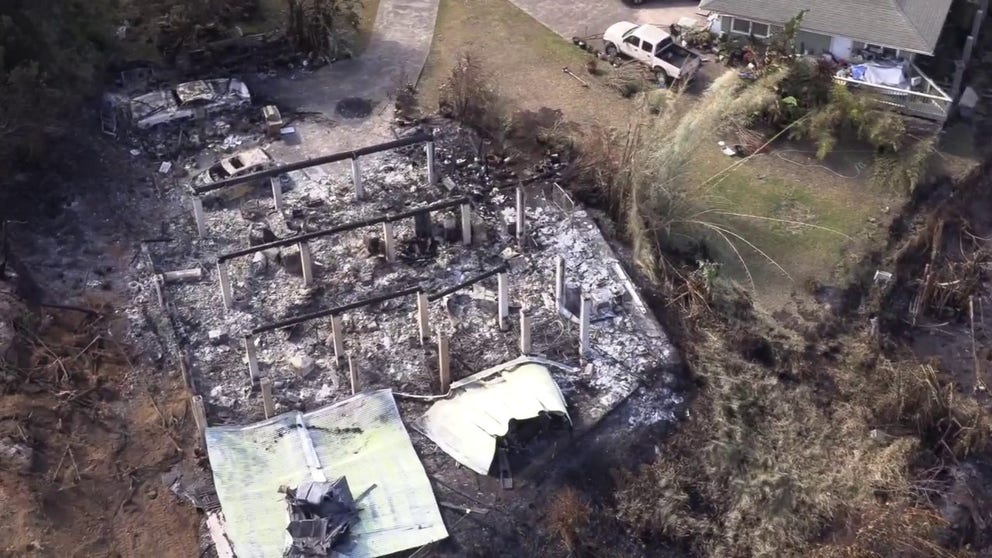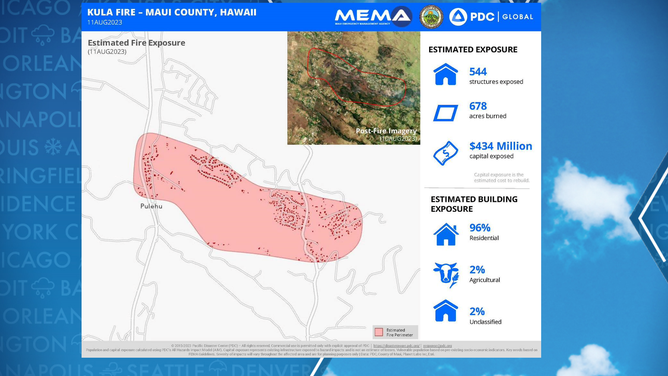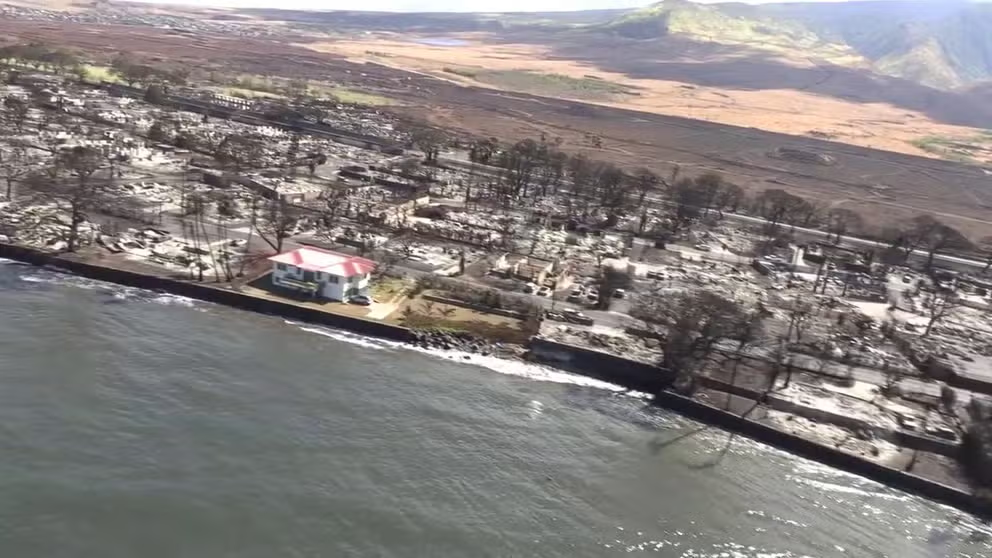Hawaii brush fires by the numbers: The scope of the catastrophic damage
The hardest hit island was reported to be Maui, where official estimates said at least 80% of the town of Lahaina had been damaged or destroyed by flames.
Watch: Aerial footage shows scope of devastating destruction after wildfire in Kula, Hawaii
The Hawaii Department of Land and Natural Resources released aerial footage above Kula, Hawaii, that shows the scope of devastation after wildfires raged across Maui.
KAHULUI, Hawaii – The scope of the disaster created by raging wildfires in Hawaii this week is coming into focus by data recently released by the Pacific Disaster Center and the Federal Emergency Management Agency.
Powerful winds helped enhance fire weather throughout the islands, which led to thousands of structures that were either damaged or destroyed and claimed the lives of at least seven dozen people.
The hardest hit island was reported to be Maui, where official estimates said at least 80% of the town of Lahaina had been damaged or destroyed by flames.
According to the most recent census, the historic town and former capital of the Kingdom of Hawaii had a population of just under 13,000 residents.
"Nobody was prepared for this … Local people have lost everything," said James Tokioka, the director of the Department of Business, Economic Development and Tourism. "They’ve lost their house. They’ve lost their animals, and it’s devastating."
The disaster is considered to be the worst in the state’s history, with lives and property that were lost forever.
BEFORE-AND-AFTER SATELLITE IMAGES OF MAUI AFTER DEADLY WIND-DRIVEN BRUSH FIRES
Nearly 100 deaths
The death toll from the fires continues to climb as search crews are just beginning to go through the rubble of thousands of businesses and homes.
So far, all fatalities have been attributed to the fire that impacted Lahaina, which was one of the most popular destinations on the west side of Maui.
Due to the nature of the terrain and ocean, exit paths were blocked by the raging inferno, forcing dozens of people to jump into the harbor.
Officials have said it could take months to search all the debris and determine the whereabouts of more than 1,000 missing people.
Maui’s police chief warned that with utility lines down and non-existent cell phone service, it is simply a matter of being unable to reach residents. Once services are restored, the agency anticipates the number of reported missing will decrease.
FIFTH-GENERATION HAWAIIAN LOSES HOME IN LAHAINA WILDFIRE
Estimates of damage reach nearly $6 billion
Data from the PDC and FEMA showed that more than $5.5 billion in capital was exposed to flames in and around Lahaina, and $400 million in property was impacted in Kula.
Kula is located about 30 miles southeast of Lahaina on the island of Maui.
Estimated costs to rebuild infrastructure were not released for any of the other islands impacted by fires.
About 86% of the buildings exposed to the fire in Lahaina were residential, and 9% were considered to be commercial.
In all, between 2,000 and 3,000 buildings were considered to be either damaged or destroyed throughout Maui.
New video of damage from Lahaina brush fires
An aerial video of damage in Lahaina, Hawaii, from deadly brush fires.
"We are not underestimating the task in front of us in the next couple of days and couple of weeks, but also a couple of years," said U.S. Sen. Brian Schatz, of Hawaii. "This is going to be a long period of recovery, but we will rebuild."
The nearly $6 billion estimate makes the fires the costliest disaster in Hawaii’s history.
The previous costliest disaster was Hurricane Iniki, which struck the islands in 1992. The Category 4 storm caused an inflation-adjusted damage amount of $3.1 billion.
HURRICANE IAN BY THE NUMBERS: THE SCOPE OF THE CATASTROPHIC DAMAGE
4,500 need shelter
Initial estimates put the need for shelters at about 4,500 people, which is more than 2% of Maui County’s entire population.
Officials have privately asked hotel operators and resorts for the potential to free up rooms for first responders and evacuees.
"I realize the amount of support that we're going to require from the federal, state, county and private, and I was talking to Governor Green and said, 'This has got to be an all-of-nation approach," said Maj. Gen. Kenneth Hara, of Hawaii’s Department of Defense.
In addition to living space, authorities estimated about 9,000 ready-to-eat meals will be needed daily, in addition to more than 3,500 gallons of water.
The documents do not give estimates for personal effects, hygiene or educational materials that will be needed.
Several charity organizations have started drives for nonperishable items for fire victims.
To donate to relief efforts, click here.




